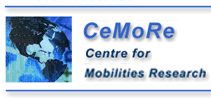

Position Statements & Abstracts
Mobilities Design - towards a new ‘material turn’
Ole B. Jensen, Aalborg University
This talk will put focus on a new way of thinking about the challenges facing mobilities in the near future. Research into the global social and environmental challenges articulate a need for new ways of thinking about social justice as well as planetary survival. However, the last decade of research into mobilities have also shown that mobilities is much more than simple physical displacements of bodies, vehicles, and information from point A to B. The practiced and lived everyday life mobilities across cultures, sites, and scales require an understanding of mobilities as an important life condition affecting notions of culture, self, Other, and the built environment. Moreover, sites and systems hosting and affording mobilities needs to be explored for their potentials to become more interesting, inspiring, and engaging. As billions of people are on the move, we need to stop thinking of this as simple acts of instrumental displacement. We become who we are as we move (or are prevented from moving) and engage in mobile practices of all sorts. Seen in this light the mobility systems of the future need to become:
- More socially inclusive
- Less environmentally restraining
- More resilient and risk adverse
- More flexible and less vulnerable
- More inspiring and attractive
- More open-minded and fun
The last decade of research into everyday life mobility has let me to articulate a research focus on the ‘mobile situations’ and how these are ‘staged’ in complex processes of infrastructural system-logics as well as in myriads of individual and incremental decisions (Jensen 2013, 2014). This is a research that asks the pragmatic question: What makes a given mobile situation possible? From the point of view of what I call ‘critical mobilties thinking’ I propose that mobilities research needs both to be ‘critical’ in relation to identifying ‘problems’ as well as ‘potentials’. Most social research on mobilities is good at the former, but less developed in relation to the latter. Therefore I have engaged with urban design, architecture and other design disciplines to explore their ‘potential seeking’ capabilities. Based on this the ‘staging mobilities’ opens up to a more design-oriented and material perspective on mobilities. Therefore I claim in this talk that we need a new ‘material turn’ in mobility research. It is a turn that orients itself towards design, space, and ‘materialities of mobilities’ much more than earlier research have done. In order to do so I propose the articulation of the new emerging research field of ‘mobilities design’ as an attempt to meet some of these challenges facing future mobility.
References
Jensen, O. B. (2013) Staging Mobilites, London: Routledge
Jensen, O. B. (2014) Designing Mobilities, Aalborg: Aalborg University Press
Between Things: Mobilities, Design & Art
Jen Southern, Lancaster University
This paper explores the intersections between the sociology of mobilities, design research, and art practice, through the parallel developments of locative media technologies and mobilities research since 2000. It is concerned with the practice of ‘doing as knowing’ and explores experimental creative practice as a research method. In this context, locative technologies as research tools invite participants to actively experiment with spatial technologies in situ, and through embodied experience of technologies, places and events to understand them in new ways.
The paper uses the example of the speculative art and design project Comob Net. The Comob Net mobile phone app simply shows the locations of multiple members of a group, and joins together their locations with a line. It was originally built for use in participatory workshop situations. In analyzing responses to the app an emerging sense of ‘comobility’, of being mobile with others at a distance, was identified. Subsequently, Comob Net has been distributed on the app store, and people world-wide have downloaded and used it. This paper describes comobility and explores how art, design, and mobilities research are combined in creative practice.
Addressing Able-ism through Research-Creation: mobility studies, critical disability studies and (Creative) Collaborative Action and Reflection Research (C-CARR).
Kim Sawchuk
In this presentation I will discuss Concordia University’s Mobile Media Lab’s (MML) intertwined engagement with critical disability studies and mobility studies (see www.mia.mobilities.ca). The focus is on how “research-creation” (Chapman and Sawchuk, 2012) has been harnessed to identify and challenge the many forms of systemic discriminations that exclude people with disabilities from fully participating in civil society. Through a series of collaborations with individuals and organizations involved in the disability rights program in Québec, the MML are attempting to address “able-sim” through an identification of “the socio-spatial forces” at work that produce “material lived and imagined differences” between the abled and the disabled. (Crooks and Chouinard, 2006:346)
Fiona Kumori Campbell defines able-ism as “a network of beliefs, processes and practices that produces a particular kind of self and body (a corporeal standard) that is projected as perfect, species-typical and therefore essential and fully human” (Campbell 2008: 153). From this point of view, people who have cognitive or physical disabilities must either strive to become that bodily or intellectual norm or find themselves distanced from the ‘able-bodied’ and excluded from the world that does not allow them to move through it with any ease. What able-ism thus presumes is that disability is inherently an undesirable individual condition that must be overcome and is never of larger social relevance. As Crooks and Chouinard argue, if able-bodiness- or able-ism-is presumed as the norm then those with disabilities are marginalized and marked as inevitably other. (2006: XX; See also Wolbring, 2008a).
To date, many of our projects have involved an examination of the complex operations of “geographies of disability” (Imrie, 1996a, 1996b, 2008; Kitchin, 1997; 1998). What if one considers mobility studies from the perspective of able-ism and able-ism from the perspective of mobility studies? What might this point of contact and set of connections reveal about the ways that hierarchies of power are structured -and designed- into our built environments? These are urgent issues that demands that we pay attention. At a local level, while over 200,000 people are estimated to be living with a physical disability in the city of Montreal the relative inaccessibility of cultural centres, movie theatres, galleries, libraries, bars, cafes, terraces and restaurants renders those with mobility impairments absent and invisible (Gouvernement de Québec 2010). These points have been documented in MML collaborative projects such as “megafone.net” in which participants in wheelchairs use cell phones to photograph how the built environment, most notably steps and stairs, sustains the marginalization and exclusion from public space. They have lead to the production of video capsules by and with people with visible and invisible disabilities (Parent, 2013) and research collaborations with blind participants who share how they navigate the city and virtual space (Dokumaci, 2013). They have lead us to re-think the conference as event and to re-work the design of our website, subjecting our habitual deign practices to the scrutiny of our participants to see how we ‘measure up’ to their assessments. In developing this media-driven research-creation work we are guided by what Virginia Eubanks has termed collaborative action and reflection research, or CARR. Eubanks defines CARR as an alternative to PAR (Participatory Action Research). In our rendition of CARR, we add yet another “C” -creative- to emphasize the use of media and ‘aesthetics’ to undertake projects from within the MML. It is this set of entanglements that will be addressed in this presentation.
Bibliography
Chapman, O. and Sawchuk K. (2012). “Research-Creation: intervention, analysis and "family resemblances” Special Issue on Media Arts Revisited, Canadian Journal of Communication, 2012, vol. 37, issue 1. 5-2, 2012.
Crooks V.A. and Chouinard, V. (2006) ‘An embodied geography of disablement: chronically ill women’s struggles for enabling spaces of health care and daily life’ Health and Place, 12: 345- 352.
Campbell, F.A. K. (2008) Refusing Able (ness): A Preliminary Conversation About Ableness, M/C Journal, 11 (3). http://journal.media-culture.org.au/index.php/mcjournal/article/viewArticle/46/0 (accessed 12 February 2013).
Dokumaci, A.
Eubanks, V. (2011). Digital Dead End: Fighting for Social Justice in the Information Age. Cambridge: MIT Press.
Imrie, R. (1996a). Ableist Geographies, Disablist Spaces: Towards a Reconstruction of Golledge's ‘Geography and the Disabled’, Transactions of the Institute of British Geographers, Vol. 21, No. 2, pp. 397-403.
Imrie, R. (1996b). Disability and the city: International perspectives. London: P. Chapman.
Imrie, R. (2008) Barriered and bounded places and the spatialities of disability. Urban Studies, 38 (1), pp. 231–237.
Kitchin, R. (1997). A Geography of, for, with or by Disabled People? Reconceptualizing the Position of Geographer as Expert. Queen's University of Belfast Socio-Spatial Analysis Research Unit Working Paper 1. Belfast: Queen's University.
Kitchin, R. (1998).‘Out of Place’, ‘Knowing One’s Place’: Space, Power and the Exclusion of Disabled People, Disability & Society, Vol. 13, No. 3, pp. 343-356.
Kobayashi, A. (1997) ‘ Paradox of difference and diversity (or, why the thresholds keep moving)’ in: Jones, III, J.P., Nast, H.J., Roberts, S.M. (eds.), Thresholds in Feminist Geography. Routledge, London and New York: 3–9.
Gouvernement de Québec (1975; 1982) Charter of Human Rights and Freedoms: updated to January 2013,
http://www2.publicationsduquebec.gouv.qc.ca/dynamicSearch/telecharge.php?type=2&file=/C_12/C12_A.html. (accessed 12 February 2013).
Parent, L. 2013. “The Politics of Snow”, conference presentation at Differential Mobilities, Movement and mediation in networked Societies, Concodia University May 8, 2013. See also www.m.i.a.mobilities.ca.
Wolbring, G. (2008b). “Oscar Pistorius and the future nature of Olympic, Paralympic and other sports” Scripted: Journal of Law, Technology and Society, Vol. 5, No. 1: 139-160.
Theorising Design of 'Human Technologies'
Jesper Simonsen, Roskilde University, Denmark
Download pdf here
Why Count Sheep, and Other Tricky Questions About Speculative Design Ethnography
Anne Galloway, Victoria University of Wellington
Governments around the world require livestock farmers to tag their animals and track their movements from birth to death. Mandated for the purposes of local biosecurity and global market access, electronic identification is also used to keep track of breeding information and health treatments. Combined with location technologies like GPS, and sensor technologies that can monitor individual animal health and external environmental conditions, livestock are now capable of generating and transmitting enormous amounts of data.
At the same time, farmers in the developed world respond to increased public concerns about animal welfare and environmental sustainability by developing new online forms of agricultural advocacy, or what they call "agvocacy". The US-based AgChat Foundation, and its equivalents in the UK, Australia and New Zealand, use social media to promote greater public awareness of agricultural practices and connect producers and consumers through weekly online chats. A "farm to fork" traceability ethos underpins agvocacy efforts, and aligns well with technosocial imperatives related to the "Internet of Things" - or the ability to connect data-rich objects (including animals) to the Internet.
For the past three years I've spent a lot of time thinking about sheep, talking about sheep, and hanging out with sheep or other people who care about sheep. I've done this because I'm interested in what the emergent technologies and politics I describe above might mean for our longest domesticated livestock animal, and for the people who continue to produce and consume them. In most ways, this has been standard STS-based ethnographic research: participant observation, interviews, etc. But the systems that I describe aren't fully formed--and may not ever fully form as imagined--so I needed to come up with complementary research methods that could help me apprehend the future, or more correctly possible futures, and for that I turned to design.
This presentation will first outline the speculative design ethnography (SDE) methods developed, and outputs created, for the "Counting Sheep: NZ Merino in an Internet of Things" research project. (I encourage people to check out the design scenarios for themselves at http://countingsheep.info/) Then I will reflect on the challenges and opportunities of this kind of hybrid research practice, paying particular attention to how future visions act in the present to construct multiple publics and co-produce knowledge. Finally, using preliminary responses to our work, I will consider the potential of SDE as a public engagement strategy, and the role of disinterested or disagreeable publics.
References:
Galloway, A. 2013. "Emergent Media Technologies, Speculation, Expectation and Human/Nonhuman Relations." Journal of Broadcasting and Electronic Media 57(1): 53-65.
Galloway, A. 2013. "Towards Fantastic Ethnography and Speculative Design." Ethnography Matters Blog. Available online at: http://ethnographymatters.net/2013/09/17/towards-fantastic-ethnography-and-speculative-design/
Intersections of mobilities, practices, and futures
Allison Hui, Sociology and DEMAND Centre, Lancaster University
Whether considering the materiality of roads or the virtuality of plans and diagrams, intersections mark out both sameness and difference. They make connections by drawing boundaries, articulating at once that which is shared and that which is not. This paper thinks through how different conceptual intersections of mobilities and everyday or professional practices matter as part of the process of transforming future mobilities to address the UK¹s aggressive emissions targets. It draws upon research in the DEMAND (Dynamics of energy, mobility and demand) Centre, based at Lancaster University and funded as part of the EPSRC/Research Councils UK End Use Energy Demand reduction programme.
Five different intersections of mobilities and practices are introduced: ways of travelling as practices, mobility as an outcome of practice, mobility infrastructures as part of practices, circulation of elements feeding the circulation of practices, and infrastructures and policy as practices. Each framing articulates different actors, materialities and interactions of interest. In addition, comparing them foregrounds what is and is not being attended to by professionals whose work directly or indirectly aims to transform mobilities.
Game Design as Rhetoric
Paul Coulton, LICA, Lancaster University
Marshall McLuhan said in his 1964 book, The Medium is the Message, “we become what we behold. We shape our tools, and thereafter our tools shape us”. In a relatively short time video games have become a major feature of our cultural landscape. This extends beyond the games themselves such that we can now see their aesthetic and iconography represented in the other main forms of media such as films, books and television - thus we are all becoming more ‘games literate’. In recognition of the significance of games we have seen approaches such as ‘gamification’ becoming widely touted as potential solutions to engaging users in all sorts of activities. Gamification solutions are generally directed toward achieving minor behavioral change using simple feedback loops that reward users actions in relation easily understood goals. However, it is difficult to see how such techniques could be scaled to address the big societal challenges, which designers often refer to as ‘wicked problems’. Such problems are not wicked in that they are evil, but rather they are difficult or impossible to solve because of incomplete, contradictory, and changing requirements. In this talk I discuss adopting design approaches inspired by the view that games are procedural rhetoric through which the messiness of wicked problems can be revealed rather than reduced.
Trailblazing (in) emergent landscapes of the possible
Thomas Binder, Royal Academy of Fine Arts, School of Design, Copenhagen
Our contemporary worlds seem at the same time to be surveyed, monitored and mapped at a scale that makes the mundane transparent and trivial to whoever has access to ‘big data’, and to be particularized, hybridized and ever proliferation to an extend that makes any foresight or projection into the future highly uncertain. Scholars of STS have taught us that agency is an outcome of ever emerging networks (Latour, 2005) and that the engagement of research participate in the messy happenings of the social (Law, 2004, Wakeford & Lury, 2012). To represent the everyday in any way that extends the particular and situated does not appear to form a stable platform for invoking predictable change whatever such a platform is appropriated politically or commercially (Thrift, 2008 ). Instead agency must be grabbed through ephemeral unfoldings of ‘the possible’ in on-going encounters between emergent practices. In this talk I will argue that these contemporary conditions are particularly visible but also appropriable in the field of design. I will suggest that classical understandings of design as privileged projections into the future based on interpretations of the past is giving way to new conceptions of design as collaborative encounters with the present from which ‘the possible’ emanates. These encounters are no longer taking place in design studios but rather in genuinely dispersed design laboratories where things and events interchangeably actualize potentialities (Binder et al. , 2011). What is performed in these design laboratories I will call rehearsals (Halse et al. 2008) and what is enacted I will suggest is a kind of trailblazing of emergent landscapes (Telier et al, 2011).
Latour, B. (2005). Reassembling the social-an introduction to actor-network-theory. Reassembling the Social-An Introduction to Actor-Network-Theory, by Bruno Latour, pp. 316. Foreword by Bruno Latour. Oxford University Press
Law, J. (2004). After method: Mess in social science research. Routledge.
Lury, C., & Wakeford, N. (Eds.). (2012). Inventive methods: The happening of the social. Routledge.
Thrift, N. (2008). Non-representational theory: Space, politics, affect. Routledge.
Binder, T., Brandt, E., Halse, J., Foverskov, M., Olander, S., & Yndigegn, S. (2011). Living the (co-design) Lab. Nordes, (4)
Halse, J., Brandt, E., Clark, B., & Binder, T. (2010). Rehearsing the future. Danish Design School Press
Telier, A., Binder, T., De Michelis, G., Ehn, P., Jacucci, G., & Wagner, I. (2011). Design things. MIT Press

![]()

![]()

